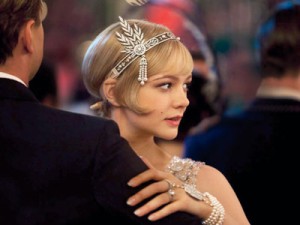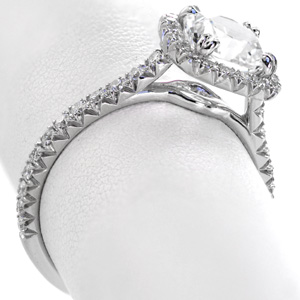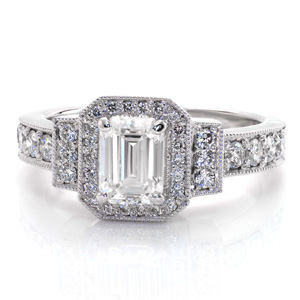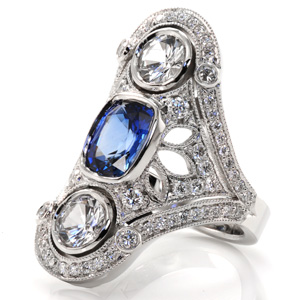Did you happen to spot the stunning diamond ring poised elegantly on Daisy Buchanan’s ring finger in The Great Gatsby? The beautiful cushion cut center surrounded in a halo of diamonds has certainly captured the attention of many. The influential attributes of the roaring twenties was portrayed in a lavish display of platinum and diamonds in Daisy’s engagement ring.

The Great Gatsby follows a cast of characters during the summer of 1922 in a prosperous town located on Long Island. The setting of the story was at the cusp of the Art Deco period where society embraced symmetry and bold geometric shapes. This portrayal of the American Dream depicts the transformational shift in culture of economic prosperity and exuberance.
Daisy’s glamorous ring showcases a cushion cut diamond which captures the timelessness of an old mine cut and the sophistication of a modern round brilliant. An old mine cut has an unmistakable vintage appeal with individual hand cut facets and a proportionate shape to its original rough form. The modified square shape of a cushion cut combines the essence of a bygone era with the sophistication of modern technology. The cushion cut is a contemporary diamond shape that embraces the romantic allure in one of the first diamond cuts in history.

The Great Gatsby story paints a picture of an American ideal where freedom includes the opportunity for prosperity and social mobility. Luxurious parties, expensive cars and platinum jewelry were a symbol of wealth and success. Daisy’s elegant platinum band was a statement of high societal standing.
This classic look was featured in a beautiful U-cut style setting. U-cut is hand created pave where each prong is cut out by hand and the metal area around the prong. The U-shape pattern is formed when a jeweler carves the metal where the diamond is placed. This design technique allows diamonds to be set closer together, giving the ring more sparkle.
The U-cut method can only be crafted in platinum due to the metals superior strength. With platinum’s durability, less metal is needed to give the appearance of an endless row of diamonds. With less metal covering the diamonds, Daisy’s ring glimmers from across the room a t every angle.

To complete the historical look, Daisy wore a matching U-cut wedding band with micro-pave diamonds. Pave, is a French word meaning ‘paving a street.’ Her ring was paved with smaller diamonds to showcase her cushion cut diamond.
Another way to display a cushion cut diamond in platinum is a V-cut pattern. In this approach, the jeweler forms an angle on each side of the metal where it meets at a point, forming a V-shape. Like the U-cut, this technique can only be custom created in platinum. Showing less metal from the prongs and more of the micro-pave diamonds will maximize the radiance of the ring.

The Art Deco ring by Knox Jewelers represents The Great Gatsby period stylistically with bold geometric shapes. Clipped corners of a rectangular halo compliment the sharp, symmetrical lines of the emerald cut center diamond. To portray the fashion of the Great Gatsby era, two raised rectangular accents are parallel to the center halo.

Another common jewelry style for the era, the combination of diamonds and sapphires. Sapphires add a rich blue color to emphasize the beauty of the center diamond. This velvety blue fashion statement is a chic way to enhance the white luster of platinum.

At Knox, we carry an entire collection of antique inspired styles in platinum or gold. As a custom design jeweler located in Minneapolis, we can create a design with or without a halo. Add surprise diamonds around the crown of the center diamond or build a halo around the diamond shape of your choice including cushion, round, oval or princess. Wear a Great Gatsby inspired ring of a timeless era, crafted with a contemporary appeal.

